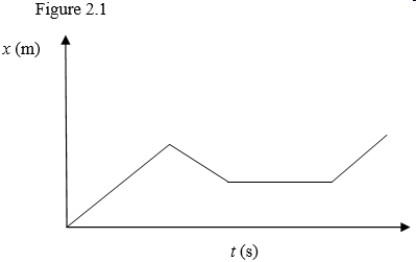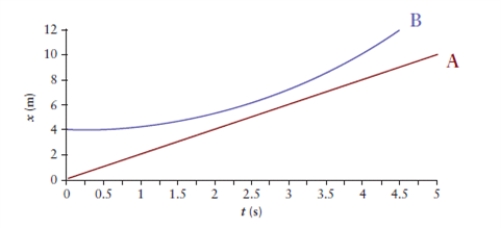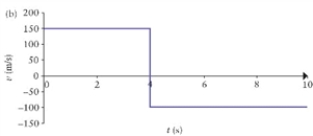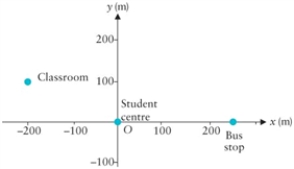Deck 2: Kinematics
Question
Question
Question
Question
Question
Question
Question
Question
Question
Question
Question
Question
Question
Question
Question
Question
Question
Question
Question
Question
Question
Question
Question
Question
Question
Question
Question
Question
Question
Question
Question
Question
Question
Question
Question
Question
Question
Question
Question
Question
Question
Question
Question
Question
Question

Unlock Deck
Sign up to unlock the cards in this deck!
Unlock Deck
Unlock Deck
1/45
Play
Full screen (f)
Deck 2: Kinematics
1
Figure 2.1 shows the x-position of an object as a function of time. Which of the following best describes the motion of the object?
A)The object moves to the right, then down, then moves to the right, then up.
B)The object moves up, falls down, stops for some time, and moves up again.
C)The object moves to the right, moves to the left, stops for a while, and again moves to the right.
D)The object moves up and to the right, then straight to the right, then up again.
A)The object moves to the right, then down, then moves to the right, then up.
B)The object moves up, falls down, stops for some time, and moves up again.
C)The object moves to the right, moves to the left, stops for a while, and again moves to the right.
D)The object moves up and to the right, then straight to the right, then up again.
The object moves to the right, moves to the left, stops for a while, and again moves to the right.
2
A bee caught inside a window walks along the bottom ledge. Starting at the left corner, it walks 50 cm to the right, then 20 cm to the left, then 8 cm to the right, and 10 cm to the left. At this time, how far is the bee from the corner?
a.28 cm
b.40 cm
c.50 cm
d.88 cm
a.28 cm
b.40 cm
c.50 cm
d.88 cm
a 

3
A person on the ground wishes to throw a ball up to her friend on the third floor balcony, 10.0 m above, from a position 1.0 m away from the side of the building. The friend on the balcony catches the ball while it is moving horizontally. To achieve this, with what speed must the friend on the ground throw the ball?
A)7.0 m/s
B)9.9 m/s
C)14.0 m/s
D)19.8 m/s
A)7.0 m/s
B)9.9 m/s
C)14.0 m/s
D)19.8 m/s
14.0 m/s
4
In a graph of velocity versus time, which of these statements correctly describes the total displacement from time t1 to time t2?
A)the slope of the line passing through the graph at time points t1 and t2
B)the area under the curve between t1 and t2
C)the maximum slope of the graph between t1 and t2
D)insufficient information provided
A)the slope of the line passing through the graph at time points t1 and t2
B)the area under the curve between t1 and t2
C)the maximum slope of the graph between t1 and t2
D)insufficient information provided

Unlock Deck
Unlock for access to all 45 flashcards in this deck.
Unlock Deck
k this deck
5
A stone is dropped from a bridge 50 m above a river. How long does it take the stone to reach the water?
A)2.26 seconds
B)3.19 seconds
C)4.52 seconds
D)4.78 seconds
A)2.26 seconds
B)3.19 seconds
C)4.52 seconds
D)4.78 seconds

Unlock Deck
Unlock for access to all 45 flashcards in this deck.
Unlock Deck
k this deck
6
What is the stopping distance for a car braking at constant deceleration of 0.5g from a speed of 120 km/hr?
A)56 m
B)70 m
C)113 m
D)140 m
A)56 m
B)70 m
C)113 m
D)140 m

Unlock Deck
Unlock for access to all 45 flashcards in this deck.
Unlock Deck
k this deck
7
A man is chased by a jaguar. The man's top speed is 20 km/hr and the jaguar's top speed is 100 km/hr. If they are 400 m apart, how many seconds elapse until the man is caught?
A)5 s
B)14.4 s
C)18 s
D)72 s
A)5 s
B)14.4 s
C)18 s
D)72 s

Unlock Deck
Unlock for access to all 45 flashcards in this deck.
Unlock Deck
k this deck
8
A shot putter can throw the shot with an initial velocity of 20 m/s from a height of 1.8 m at an angle of 30 degrees to the horizontal. With what speed does the shot hit the ground?
A)10 m/s
B)11.63 m/s
C)20 m/s
D)20.86 m/s
A)10 m/s
B)11.63 m/s
C)20 m/s
D)20.86 m/s

Unlock Deck
Unlock for access to all 45 flashcards in this deck.
Unlock Deck
k this deck
9
Blood in the aorta accelerates from rest to 0.4 m/s over a distance of 2 cm. What is the average acceleration?
A)4 m/s2
B)4 m2/s2
C)8 m2/s
D)8 m/s2
A)4 m/s2
B)4 m2/s2
C)8 m2/s
D)8 m/s2

Unlock Deck
Unlock for access to all 45 flashcards in this deck.
Unlock Deck
k this deck
10
Which of these statements tells you that, from a graph of displacement versus time, the velocity at point (t2, x2) is greater than the velocity at another point, (t1, x1)?
A)The vertical coordinate at point (t2, x2) is greater.
B)The slope of the tangent is greater.
C)The slope at (t2, x2) is increasing.
D)The slope at (t1, x1) is decreasing.
A)The vertical coordinate at point (t2, x2) is greater.
B)The slope of the tangent is greater.
C)The slope at (t2, x2) is increasing.
D)The slope at (t1, x1) is decreasing.

Unlock Deck
Unlock for access to all 45 flashcards in this deck.
Unlock Deck
k this deck
11
A top with a diameter of 5.00 cm is spinning at 200.00 revolutions per minute. What is the centripetal acceleration at the rim?
A)1.97 m/s2
B)3.95 m/s2
C)5.59 m/s2
D)7.90 m/s2
A)1.97 m/s2
B)3.95 m/s2
C)5.59 m/s2
D)7.90 m/s2

Unlock Deck
Unlock for access to all 45 flashcards in this deck.
Unlock Deck
k this deck
12
A ball is thrown vertically upward at 10 m/s. How high does the ball rise?
A)2.5 m
B)5.1 m
C)10.2 m
D)15.3 m
A)2.5 m
B)5.1 m
C)10.2 m
D)15.3 m

Unlock Deck
Unlock for access to all 45 flashcards in this deck.
Unlock Deck
k this deck
13
A boy runs around a neighbourhood block in 10 minutes for a total distance of 2 km. What are his average velocity and speed in km/s?
A)12, 12
B)12, 0
C)0, 12
D)not enough information provided
A)12, 12
B)12, 0
C)0, 12
D)not enough information provided

Unlock Deck
Unlock for access to all 45 flashcards in this deck.
Unlock Deck
k this deck
14
A migrating bird will travel nonstop at a fixed speed of 40 km/hr (in still air) over a distance of 2000 km due south of its present position; however, there is a west wind of 30 km/hr. What is the time required for the bird to reach its destination?
A)37.8 hours
B)53.5 hours
C)75.6 hours
D)106.9 hours
A)37.8 hours
B)53.5 hours
C)75.6 hours
D)106.9 hours

Unlock Deck
Unlock for access to all 45 flashcards in this deck.
Unlock Deck
k this deck
15
A bird flies north at 60 km/hr for 2 minutes, then east at 70 km/hr for 5 minutes, and finally lands after flying south at 80 km/hr for 3 minutes. What is the displacement of the landing point from the take-off point?
A)2.04 km, 19 degrees north of east
B)2.04 km, 19 degrees south of east
C)11.83 km, 20 degrees north of east
D)11.83 km, 45 degrees south of east
A)2.04 km, 19 degrees north of east
B)2.04 km, 19 degrees south of east
C)11.83 km, 20 degrees north of east
D)11.83 km, 45 degrees south of east

Unlock Deck
Unlock for access to all 45 flashcards in this deck.
Unlock Deck
k this deck
16
A ball is thrown from a building at an angle of 45 degrees above the horizontal. If the ball were thrown in the same way from a floor at twice the height, by what factor does the distance from the building at which the ball reaches the ground increase?
A) 2
2
B)2
C)2 2
2
D)insufficient information
A)
 2
2B)2
C)2
 2
2D)insufficient information

Unlock Deck
Unlock for access to all 45 flashcards in this deck.
Unlock Deck
k this deck
17
A boy throws a ball at an angle of 60 degrees above the horizontal with a speed of 12.00 m/s. After 2 s, what is the distance of the ball from the boy?
A)1.18 m
B)10.82 m
C)12.06 m
D)24.0 m
A)1.18 m
B)10.82 m
C)12.06 m
D)24.0 m

Unlock Deck
Unlock for access to all 45 flashcards in this deck.
Unlock Deck
k this deck
18
Figure 2.2 
Figure 2.2 represents position as a function of time for object A and object B. Which of the following statements correctly describes a comparison of the velocity and the acceleration of objects A and B?
A)The velocity of B is always larger than the velocity of A.
B)The acceleration of A is larger than the acceleration of B at time 1.5 s.
C)The velocity of A is larger than the velocity of B at time 1.5 s.
D)The acceleration of A is always larger than the acceleration of B.

Figure 2.2 represents position as a function of time for object A and object B. Which of the following statements correctly describes a comparison of the velocity and the acceleration of objects A and B?
A)The velocity of B is always larger than the velocity of A.
B)The acceleration of A is larger than the acceleration of B at time 1.5 s.
C)The velocity of A is larger than the velocity of B at time 1.5 s.
D)The acceleration of A is always larger than the acceleration of B.

Unlock Deck
Unlock for access to all 45 flashcards in this deck.
Unlock Deck
k this deck
19
The Moon orbits Earth in an approximately circular orbit at a distance of 380000 km in 27.3216 days. What is the centripetal acceleration of the Moon?
A)0.0272 m/s2
B)0.0068 m/s2
C)0.0027 m/s2
D)0.0014 m/s2
A)0.0272 m/s2
B)0.0068 m/s2
C)0.0027 m/s2
D)0.0014 m/s2

Unlock Deck
Unlock for access to all 45 flashcards in this deck.
Unlock Deck
k this deck
20
While flying horizontally at a speed of 5.0 m/s, an owl accidentally drops a mouse it is carrying. The mouse drops to the ground, 10.0 m below. What is the impact velocity with which the mouse hits the ground?
A)14.9 m/s, at angle of 70.35 degrees below the horizontal
B)14.9 m/s, at angle of 70.35 degrees above the horizontal
C)20.0 m/s, at angle of 70.35 degrees below the horizontal
D)20.0 m/s, at angle of 70.35 degrees above the horizontal
A)14.9 m/s, at angle of 70.35 degrees below the horizontal
B)14.9 m/s, at angle of 70.35 degrees above the horizontal
C)20.0 m/s, at angle of 70.35 degrees below the horizontal
D)20.0 m/s, at angle of 70.35 degrees above the horizontal

Unlock Deck
Unlock for access to all 45 flashcards in this deck.
Unlock Deck
k this deck
21
For an object moving along a straight line, in order to return to its starting point it does not necessarily have a speed of zero during the time lapse of its motion.

Unlock Deck
Unlock for access to all 45 flashcards in this deck.
Unlock Deck
k this deck
22
One centrifuge has twice the diameter of a second one, and half its number of revolutions per minute. Particles in suspension in the two centrifuges will feel the same centripetal acceleration.

Unlock Deck
Unlock for access to all 45 flashcards in this deck.
Unlock Deck
k this deck
23
The figure below shows the velocity of an object as a function of time.
(a) What is the average velocity from the start to the end at 10 s?
(b) What is the displacement of an object from 2 s to 8 s?
(a) What is the average velocity from the start to the end at 10 s?
(b) What is the displacement of an object from 2 s to 8 s?


Unlock Deck
Unlock for access to all 45 flashcards in this deck.
Unlock Deck
k this deck
24
If a car brakes at constant deceleration, the stopping distance is doubled when the initial speed is twice as great.

Unlock Deck
Unlock for access to all 45 flashcards in this deck.
Unlock Deck
k this deck
25
A weight is swung on the end of a string in a horizontal plane, with a certain period of revolution. If the string is shortened to half its length, and the revolution period is kept the same, the centripetal acceleration of the weight is halved.

Unlock Deck
Unlock for access to all 45 flashcards in this deck.
Unlock Deck
k this deck
26
Meissner's corpuscles, the mechanism for physiological detection of velocity in humans, detect how fast the body is moving with respect to its surroundings.

Unlock Deck
Unlock for access to all 45 flashcards in this deck.
Unlock Deck
k this deck
27
A student drew the coordinate system below to plot major points of interest on the university campus.  (a) What are the coordinates of the classroom, the student centre, and the bus stop in this system?
(a) What are the coordinates of the classroom, the student centre, and the bus stop in this system?
(b) If the student set up a coordinate system with the origin in the classroom, what would then be the coordinates of the student centre and the bus stop?
(c) How would the distance between the student centre and the bus stop change with the change of a coordinate system?
 (a) What are the coordinates of the classroom, the student centre, and the bus stop in this system?
(a) What are the coordinates of the classroom, the student centre, and the bus stop in this system?(b) If the student set up a coordinate system with the origin in the classroom, what would then be the coordinates of the student centre and the bus stop?
(c) How would the distance between the student centre and the bus stop change with the change of a coordinate system?

Unlock Deck
Unlock for access to all 45 flashcards in this deck.
Unlock Deck
k this deck
28
One athlete can accelerate to a maximum speed of 15 m/s in 2 s, but can maintain that speed for only 20 s. A second athlete reaches a maximum speed of 20 m/s in 2 s, but can maintain it for only 15 s. Which athlete runs the longer distance? Describe your reasoning.

Unlock Deck
Unlock for access to all 45 flashcards in this deck.
Unlock Deck
k this deck
29
Neglecting air resistance, a ball thrown horizontally with a certain velocity from 10 floors up a building will hit the ground at twice the distance from the building as if it were thrown from 5 floors up.

Unlock Deck
Unlock for access to all 45 flashcards in this deck.
Unlock Deck
k this deck
30
For a car braking with constant deceleration, the time to stop is doubled when the speed of the car before braking is doubled.

Unlock Deck
Unlock for access to all 45 flashcards in this deck.
Unlock Deck
k this deck
31
A ball thrown upward at a given speed will reach the ground with the same speed as the initial speed, regardless of the angle at which it is thrown.

Unlock Deck
Unlock for access to all 45 flashcards in this deck.
Unlock Deck
k this deck
32
The figure below shows the x-position of an object as a function of time.
(a) At which point does the object have the smallest non-zero speed?
(b) At which point does the object have the largest speed?
(c) At which point is the object at rest?
(d) At which point is the object moving to the left?
(a) At which point does the object have the smallest non-zero speed?
(b) At which point does the object have the largest speed?
(c) At which point is the object at rest?
(d) At which point is the object moving to the left?


Unlock Deck
Unlock for access to all 45 flashcards in this deck.
Unlock Deck
k this deck
33
A fly crawls in a zigzag pattern along a line where the angle that successive straight-line segments of its path make with the general direction of motion is 60 degrees. The total distance the fly crawls is twice the distance between the end points of its path.

Unlock Deck
Unlock for access to all 45 flashcards in this deck.
Unlock Deck
k this deck
34
The mechanism for physiological detection of acceleration of the body in humans is called Meissner's corpuscles.

Unlock Deck
Unlock for access to all 45 flashcards in this deck.
Unlock Deck
k this deck
35
Compare the order of magnitude of the accelerations of a human being in a crowd where the average distance apart is 3 m and the speed of walking is 4 km/hr, to those of microscopic particles of the order of 5 ìm apart being jostled by their neighbours several hundreds of times every second.

Unlock Deck
Unlock for access to all 45 flashcards in this deck.
Unlock Deck
k this deck
36
One athlete can accelerate to a maximum speed of 15 m/s in 2 s, but can maintain that speed for only 20 s. A second athlete reaches a maximum speed of 20 m/s, but can maintain it for only 15 seconds. Which athlete will have run farther after 10 seconds?

Unlock Deck
Unlock for access to all 45 flashcards in this deck.
Unlock Deck
k this deck
37
If a car accelerates from a stationary starting position, what difference would it make to the velocity of the car to gradually increase the amount of acceleration to some maximum value, rather than maintain the acceleration at this maximum value from the beginning?

Unlock Deck
Unlock for access to all 45 flashcards in this deck.
Unlock Deck
k this deck
38
A bird flies in a straight line at 50 km/hr for 2 minutes, and after taking off again flies in a straight line at 40 km/hr for 3 minutes before landing a second time. What are the maximum and minimum distances that the bird can be from its initial position after the second landing?

Unlock Deck
Unlock for access to all 45 flashcards in this deck.
Unlock Deck
k this deck
39
At some point on the graph of displacement versus time, between two points, the instantaneous velocity equals the average velocity between those points.

Unlock Deck
Unlock for access to all 45 flashcards in this deck.
Unlock Deck
k this deck
40
A train travelling at 200 km/hr has to brake due to an obstruction on the track 1 km ahead. The maximum braking deceleration that can be applied is 0.2g. The train will be able to stop before hitting the obstruction.

Unlock Deck
Unlock for access to all 45 flashcards in this deck.
Unlock Deck
k this deck
41
A ball is thrown parallel to the ground at a height of 1 m. Another ball is thrown at an angle of 45 degrees above the horizontal from ground level with the same speed. Which of these methods would result in the ball travelling further until its first bounce?

Unlock Deck
Unlock for access to all 45 flashcards in this deck.
Unlock Deck
k this deck
42
An athlete throws a putt at an angle of 30 degrees to the horizontal. A second athlete throws a putt at 45 degrees to the horizontal but at 95% of the initial speed of the first athlete. Which athlete threw the putt further?

Unlock Deck
Unlock for access to all 45 flashcards in this deck.
Unlock Deck
k this deck
43
Describe in general terms the advantages and disadvantages of building larger-diameter centrifuges spinning at a certain rate, as opposed to centrifuges of the same size but that spin faster.

Unlock Deck
Unlock for access to all 45 flashcards in this deck.
Unlock Deck
k this deck
44
If football is to be played on the Moon, describe the conditions that differ from those on Earth that you would need to take into consideration to design the playing field.

Unlock Deck
Unlock for access to all 45 flashcards in this deck.
Unlock Deck
k this deck
45
If the centripetal acceleration of a body revolving around a centre of attraction increased when its distance from the centre decreased, describe in general terms the shape that the path of the body looked like.

Unlock Deck
Unlock for access to all 45 flashcards in this deck.
Unlock Deck
k this deck



